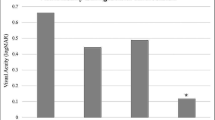Abstract
Purpose
To investigate the risk factors associated with corneal epithelial defects (CED) and delayed healing (exceeding 1 week) following pars plana vitrectomy (PPV).
Methods
This retrospective study enrolled patients who underwent PPV at a single center in Taiwan between 2011 and 2012. Medical records were reviewed, including demographic, underlying disease, surgical indication, operation parameters, and existence of CED. These data were statistically analyzed. All patients were evaluated during follow-ups at day 1 and week 1 after PPV. Patients with persistent CED 1 week after PPV were diagnosed with delayed healing.
Results
A total of 255 patients were included in the study, consisting of 139 men and 116 women, with a mean age of 56.9 years. PPV was performed under the indications of rhegmatogenous retinal detachment (RRD), diabetic retinopathy, or vitreoretinal interface disease. Out of 255 eyes, 59 developed CED 1 day after surgery (23.1%), and CED was associated with younger age, diabetes mellitus (DM), RRD, longer duration of surgery, and silicon oil use during surgery. Among them, seven patients (11.9%) demonstrated delayed healing, which was associated with a higher rate of DM (p = 0.085), compared to patients who healed within 1 week.
Conclusion
Patients with RRD, longer duration of surgery, and DM may be at risk of developing CED after PPV. In addition, patients with DM demonstrated a higher incidence of delayed corneal healing.
Similar content being viewed by others
References
Chen WL, Lin CT, Ko PS, Yeh PT, Kuan YH, Hu FR, Yang CM (2009) In vivo confocal microscopic findings of corneal wound healing after corneal epithelial debridement in diabetic vitrectomy. Ophthalmology 116(6):1038–1047
Chen HF, Yeung L, Yang KJ, Sun CC (2016) Persistent corneal epithelial defect after pars plana vitrectomy. Retina 36(1):148–155
Vivante A, Golan E, Tzur D, Leiba A, Tirosh A, Skorecki K, Calderon-Margalit R (2012) Body mass index in 1.2 million adolescents and risk for end-stage renal disease. Arch Intern Med 172(21):1644–1650
Chiambo S, Bailez Fidalgo C, Pastor Jimeno JC, Coco Martin RM, de la Rua Rodriguez, Franch E, De la Fuente Salinero MA, Herreras Cantalapiedra JM (2004) Corneal epithelial complications after vitrectomy: a retrospective study. Arch Soc Esp Oftalmol 79(4):155–161
Hiraoka M, Amano S, Oshika T, Kato S, Hori S (2001) Factors contributing to corneal complications after vitrectomy in diabetic patients. Jpn J Ophthalmol 45(5):492–495
Schulze SD, Sekundo W, Kroll P (2006) Autologous serum for the treatment of corneal epithelial abrasions in diabetic patients undergoing vitrectomy. Am J Ophthalmol 142(2):207–211
Didenko TN, Smoliakova GP, Sorokin EL, Egorov VV (1999) Clinical and pathogenetic features of neurotrophic corneal disorders in diabetes. Vestn Oftalmol 115(6):7–11
Wang Y, Zhou Q, Xie L (2014) Diabetic keratopathy: new progresses and challenges. Zhonghua Yan Ke Za Zhi 50(1):69–72
Bikbova G, Oshitari T, Tawada A, Yamamoto S (2012) Corneal changes in diabetes mellitus. Curr Diabetes Rev 8(4):294–302
Friberg TR, Ohji M, Scherer JJ, Tano Y (2003) Frequency of epithelial debridement during diabetic vitrectomy. Am J Ophthalmol 135(4):553–554
Friberg TR, Guibord NM (1999) Corneal endothelial cell loss after multiple vitreoretinal procedures and the use of silicone oil. Ophthalmic Surg Lasers 30(7):528–534
Abrams GW, Azen SP, Barr CC, Lai MY, Hutton WL, Trese MT, Irvine A, Ryan SJ (1995) The incidence of corneal abnormalities in the Silicone Study. Silicone Study Report 7. Arch Ophthalmol 113(6):764–769
Klaassen-Broekema N, van Bijsterveld OP (1993) Limbal and corneal calcification in patients with chronic renal failure. Br J Ophthalmol 77(9):569–571
Ignat F, Davidescu L, Mota E, Godeanu L (1999) The ocular changes in patients on chronic dialysis. Oftalmologia 46(1):23–30
Ozdemir M, Bakaris S, Ozdemir G, Buyukbese MA, Cetinkaya A (2004) Ocular surface disorders and tear function changes in patients with chronic renal failure. Can J Ophthalmol 39(5):526–532
Mullaem G, Rosner MH (2012) Ocular problems in the patient with end-stage renal disease. Semin Dial 25(4):403–407
Popa M, Nicoara S (2000) Ocular changes in dialysis patients. Oftalmologia 50(1):65–67
Tokuyama T, Ikeda T, Sato K, Mimura O, Morita A, Tabata T (2002) Conjunctival and corneal calcification and bone metabolism in hemodialysis patients. Am J Kidney Dis 39(2):291–296
Chifflet S, Justet C, Hernandez JA, Nin V, Escande C, Benech JC (2012) Early and late calcium waves during wound healing in corneal endothelial cells. Wound Repair Regen 20(1):28–37
Locatelli F, Cannata-Andia JB, Drueke TB, Horl WH, Fouque D, Heimburger O, Ritz E (2002) Management of disturbances of calcium and phosphate metabolism in chronic renal insufficiency, with emphasis on the control of hyperphosphataemia. Nephrol Dial Transplant 17(5):723–731
Covic A, Rastogi A (2013) Hyperphosphatemia in patients with ESRD: assessing the current evidence linking outcomes with treatment adherence. BMC Nephrol. doi:10.1186/1471-2369-14-153
Acknowledgements
The authors appreciate the Biostatistics Center, Kaohsiung Chang Gung Memorial Hospital, for statistics work.
Disclosure
The authors have no proprietary or commercial interest in any materials discussed in this article.
Author information
Authors and Affiliations
Corresponding author
Rights and permissions
About this article
Cite this article
Chiang, WY., Lee, JJ., Kuo, HK. et al. Factors associated with corneal epithelial defects after pars plana vitrectomy. Int Ophthalmol 38, 105–110 (2018). https://doi.org/10.1007/s10792-016-0429-7
Received:
Accepted:
Published:
Issue Date:
DOI: https://doi.org/10.1007/s10792-016-0429-7




